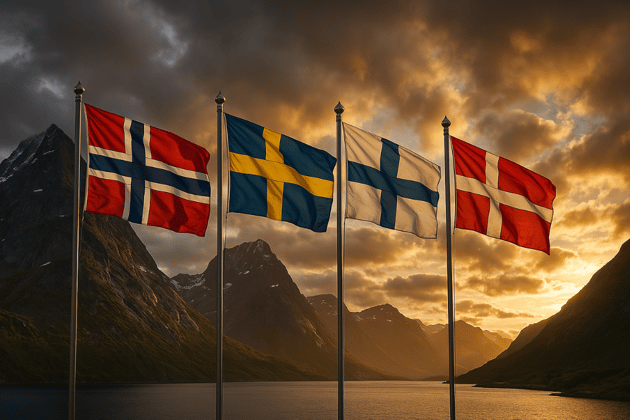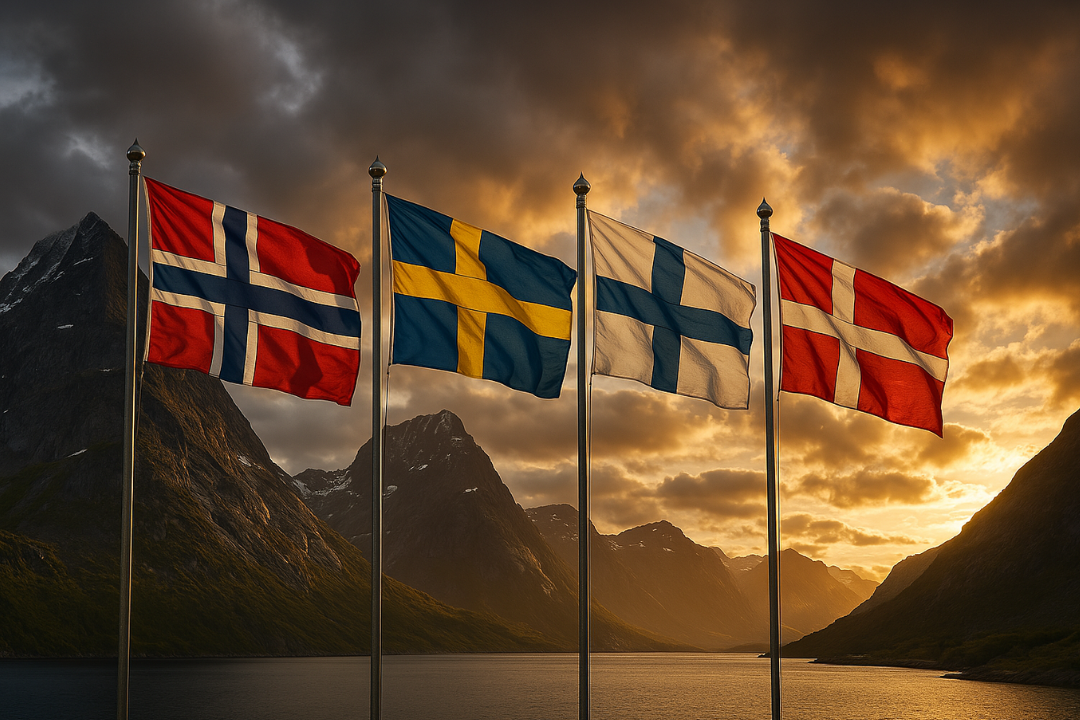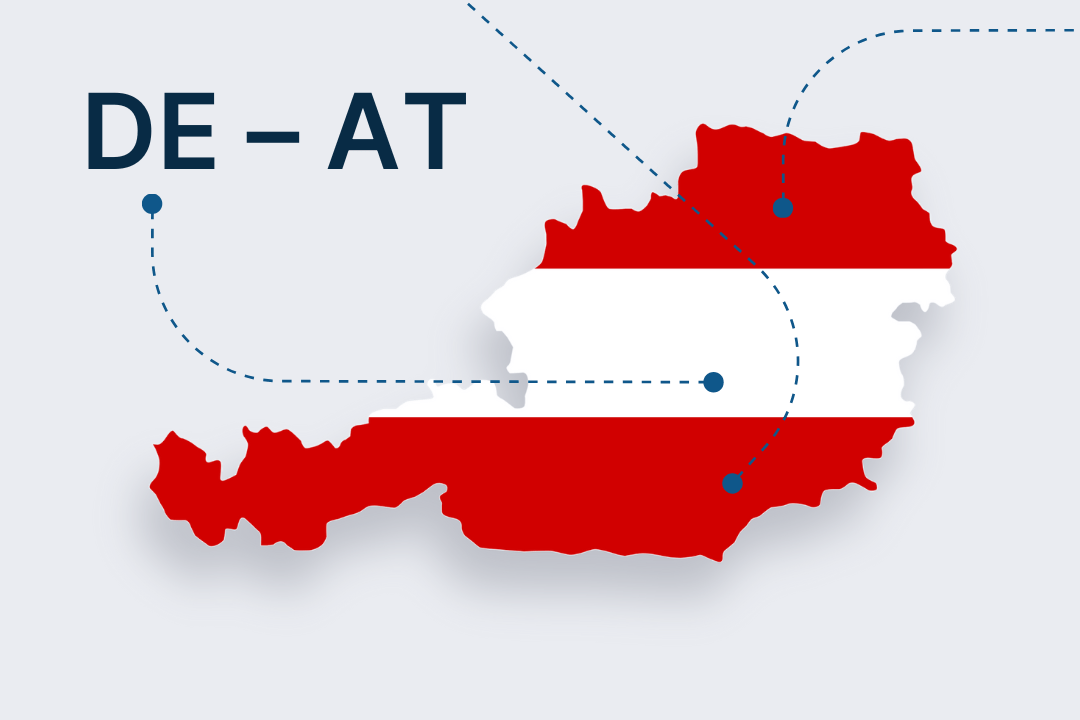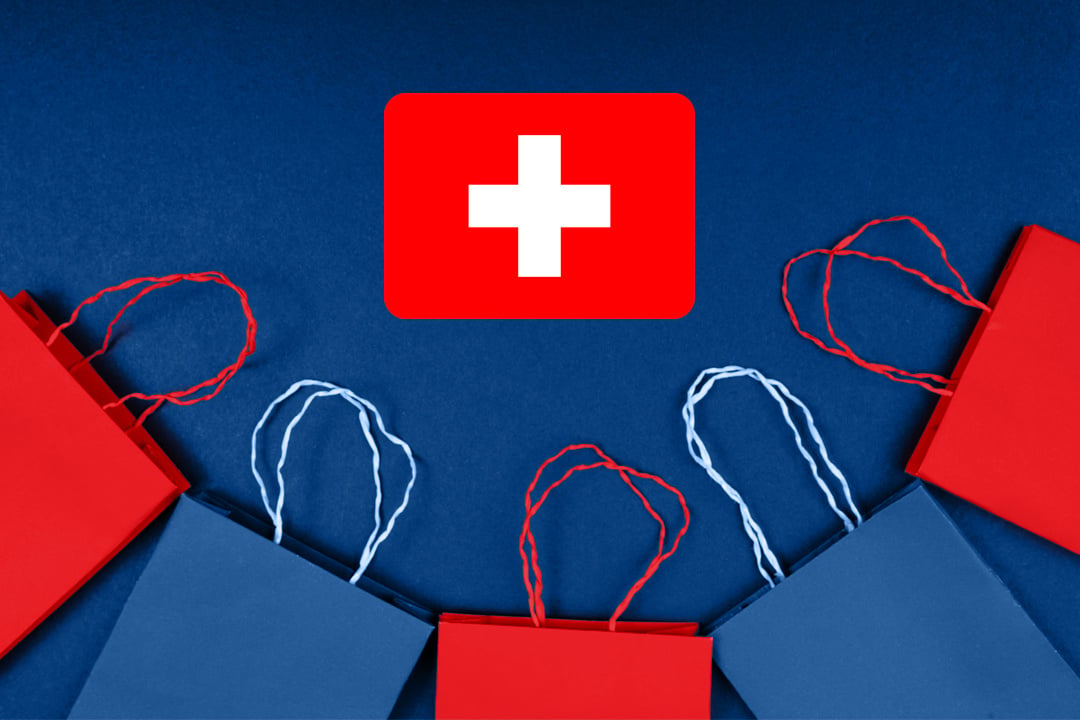Market information and tips on taxes, payments and returns management for shippi...
Shipping to Norway, Sweden, Finland & Denmark
Opportunities and tips for online retailers

Opportunities and tips for online retailers
E-commerce is booming in the Nordic countries - Sweden, Norway, Denmark and Finland. Digital affinity and high purchasing power make these markets particularly attractive for online retailers. However, shipping to Norway in particular can be complicated due to the special customs and tax regulations for countries outside the EU. But with the right shipping partner, it doesn't have to be.
In this article, we identify the market opportunities offered by the Nordic countries, provide the latest figures and explain how you can ship goods to Norway efficiently - without any unpleasant surprises when it comes to customs clearance.
The e-commerce market in the north: Figures, trends and potentials
The Nordic countries are among the most attractive e-commerce markets in Europe. Why is that? Consumers in Sweden, Norway, Denmark and Finland are digitally savvy and shop online more than the average: Internet penetration is over 94 per cent in all Nordic countries. In 2024, Denmark and Norway will lead the way with 98 percent. According to PostNord, an average of 83 per cent of people in the Nordic countries shop online at least once a month - in Sweden this figure rises to 88 per cent. Apparel, shoes, cosmetics and electronics are the main items purchased online.
Scandinavian customers generally prefer to purchase from international retailers. In the PostNord study, Germany is the second most popular country for cross-border e-commerce outside Scandinavia, after China. German products also enjoy a good reputation - they stand for quality and reliability.
What's more, the Scandinavian population has particularly high purchasing power. Norway is the fourth wealthiest country in the world, with a per capita gross domestic product (GDP) of around USD 87,000. Denmark ranks tenth with a GDP per capita of just over USD 68,000. Sweden and Finland are also well above the EU average, with GDP per capita of over USD 50,000.
Overall, e-commerce is growing rapidly in Scandinavia: Statista predicts e-commerce sales in Sweden to reach around 13.64 billion Euro in 2025 and 18.61 billion Euro in 2029. In Norway, e-commerce sales are forecast to reach 8.84 billion Euro in 2025. In 2029, it is expected to reach 12 billion Euro. Finnland and Denmark have similar growth rates.
These conditions make the North an attractive market for online retailers, full of opportunities - but also challenges. In particular, shipping to Norway requires good preparation, as the country is not part of the EU and has its own customs rules and regulations (more on this later).
The Scandinavian markets in detail: shopping trends and characteristics
Not all Nordic markets work the same way. Here are more detailed insights into the special features of the four countries, based on the latest figures from PostNord and Statista.
🇸🇪 Sweden
Sweden is the strongest e-commerce market in Scandinavia. Almost 88 per cent of Swedes shop online at least once a month. Most of them place an order from abroad at least once a quarter. After China, the most popular shopping destinations are Germany, the UK and Denmark. The most common reason for Swedish consumers to cancel an order during check-out is that the shipping price is too high.
Most popular marketplaces |
Local marketplaces |
Preferred payment methods
|
Returs |
|
|
|
29 % of customers have returned an order in the last three months according to PostNord; mainly younger consumers; preferably using a parcel shop |
🇫🇮 Finland
The Finnish e-commerce market is growing rapidly. 79 per cent of Finns order online at least once a month. 39 per cent buy from international shops at least once a month - particularly frequently in Germany or Sweden. Most shoppers prefer to collect their orders from a parcel station.
Most popular marketplaces
|
Local marketplaces |
Preferred payment methods |
Returs |
|
|
|
According to PostNord, 25% of customers have returned an order in the last three months; preferably via parcel stations or parcel shops |
🇩🇰 Denmark
Denmark is the most international e-commerce market in the Nordic countries. 83 per cent of Danes shop online at least once a month. A full 54 per cent order from international shops every month - primarily in Germany and Sweden. And 68 per cent prefer to pay conveniently by credit card or MobilePay. Moreover, they expect fast deliveries in less than six days.
Most popular marketplaces |
Local marketplaces |
Preferred payment methods |
Returns |
|
|
|
According to PostNord, 33% of customers have returned an order in the last three months; preferably via parcel shops |
🇳🇴 Norway
People in Norway prefer receiving home deliveries - either directly to their front door or in their letterbox. 83 per cent of Norwegians shop online every month and 48 per cent order from international retailers at least once a month. A third of Norwegian consumers cancel orders at check-out if the shipping costs are too high.
Most popular marketplaces |
Local marketplaces
|
Preferred payment methods
|
Returns |
|
|
|
According to PostNord, 29% of customers have returned an order in the last three months; preferably through parcel stations or home collection |
Special case of shipping to Norway: What are the challenges?
Standardised EU rules make it relatively easy to send parcels from Germany to Sweden, Finland and Denmark. Sending a parcel to Norway is a little more complicated: as Norway is not an EU member state, special rules and regulations apply here, for example when it comes to customs clearance.
These are the four main challenges:
1. Customs duties and taxes
Shipping to Norway is subject to Norwegian VAT (MVA) and customs duties. These additional costs can make the ordering process more expensive and act as a potential barrier.
Norwegian customers are used to transparent tariffs and don't want any surprises when it comes to delivery. Retailers should therefore clearly communicate whether they are paying taxes and duties or whether they will be paid on receipt. Lack of information can quickly lead to a purchase being cancelled.
2. Customs declaration
Each delivery to Norway must be declared to customs by the consignor - with complete and correct information. This includes:
- HS-Code for the product category
- Value of the goods for calculating customs duties
- Country of origin of the products
- Shipping and payment terms
If declarations are missing or incorrect, the shipment will be delayed or returned to the country of destination. The Norwegian customs authorities often check larger shipments manually, which takes time and can result in additional fees. Correct customs clearance saves time and frustration.
3. Delivery times
While shipments within the EU often arrive within a few days, shipments to Norway can take significantly longer due to customs clearance. This is particularly problematic for products such as clothing or electronics, where fast delivery times are expected.
According to PostNord, 87 percent of Norwegian online shoppers expect their order to be delivered within five days. Retailers should therefore choose an efficient shipping solution with shipment tracking to remain competitive and make the shipping process as transparent as possible for customers.
4. Returns
Returns can be particularly challenging as they can be charged with duties and taxes. Depending on the shipping method, a return may even have to go through customs again - an expensive and impractical solution.
The VOEC process (read below) can help by facilitating returns and minimising costs for retailers and customers. Well structured returns management is essential to ensure a smooth delivery to Norway and an optimal shopping experience for the customer.
Especially online marketplaces attach great importance to compliance withs Service Level Agreements (SLAs) and make specific demands on retailers to ensure good service quality and customer satisfaction. This often includes clear rules for processing returns. Retailers should therefore be familiar with the requirements of the marketplace.
Customs procedure for shipping to Norway: Regular or VOEC
Shipping goods to Norway has two options at customs: the regular customs procedure or the simplified VOEC procedure. Which procedure is the most suitable depends on the type and size of the shipment, the value of the products and the company structure.
1. Regular customs clearance: Standard processing with duties
In the regular customs procedure, each shipment undergoes standard customs clearance. This means:
- VAT obligation: All goods are subject to Norwegian VAT of 25 per cent (15 per cent for foods).
- Customs duties: A full customs declaration must be made in the Norwegian customs system TVINN. Norwegian import import sales tax and, where required, customs duties must be paid. These import duties apply to certain categories of goods, such as clothing and foods.
- Customs clearance by carriers: Retailers can handle customs clearance themselves or delegate it to shipping service providers such as DHL, UPS or PostNord.
- Increased delivery times: Customs inspection can take several days, especially for larger shipments.
When does the regular procedure pay off?
The regular customs procedure applies to high-priced goods that do not qualify for the simplified VOEC procedure. Companies selling goods with a retail price of more than NOK 3,000 (approx. 260-300 Euro) should be prepared for the regular customs procedure. The same applies to certain restricted goods and sales to business customers (more on this in the next section).
2. VOEC: Simplified customs clearance for small shipments
To ease international online trade, Norway introduced the VOEC procedure (VAT On E-Commerce) in 2020. This means that VAT is calculated at the time of purchase, which speeds up shipping and simplifies customs clearance.
The VOEC procedure has the following requirements:
- Retailers must register with the Norwegian tax authorities in the VOEC system.
- The unit price of an item must not exceed 2,999 NOK (ca. 260-300 EUR).
- The NOK 2,999 exemption limit applies per item, not to the entire shopping basket. Shipping and insurance costs are not included in the value of the goods, but are subject to VAT.
- Retailers must sell the products in their own name and for their own account. For marketplaces such as Zalando, Amazon & Co., the supplier must be clearly identified.
- Food, alcohol, tobacco, medicines and products subject to excise duty are excluded from the VOEC procedure.
The VOEC procedure offers clear advantages over the regular customs procedure: There are no import duties and only the Norwegian VAT of 25 per cent is applied directly at the time of purchase. This reduces the administrative burden for the retailer. Since the TVINN system also removes the need for a customs declaration, customers also benefit from faster delivery times and clear prices without unexpected charges. Customer satisfaction increases and retailers gain a competitive advantage through the simplified process.
When does VOEC pay off?
VOEC is ideal for e-commerce companies that regularly ship „Low Value Goods“ wsuch as clothing, books or electronics to Norway. Retailers save time and customers benefit from a smooth shopping experience.
Important: Retailers using the VOEC procedure must clearly display the VOEC number during the checkout process and ensure that VAT is collected directly at the time of purchase. The VOEC procedure also only applies to sales to private individuals (B2C). Sales to businesses (B2B) are subject to the regular customs procedure.

How exporto simplifies shipping to the Nordics
exporto is the first provider to integrate the regular customs procedure and the VOEC procedure into a single flexible end-to-end solution. This allows companies to choose the most efficient customs clearance option according to their needs. Anyone who meets the requirements for the VOEC procedure can use exporto to ship goods to Norway duty-free.
These are all of exporto's benefits for shipping to Norway, Sweden, Denmark and Finland at a glance:
- Plug and play: A single connection provides access to all Nordic markets.
- Customs clearance flexibility: When shipping to Norway, retailers can choose between the regular customs procedure and the VOEC procedure to find the best solution for their business.
- Automated customs processes: When shipping to Norway, exporto provides all the necessary documents for fast, fully automated customs clearance. As a retailer, you benefit from short processing times and late, flexible cut-offs.
- Fast delivery: Whether to Sweden, Norway, Denmark or Finland - with exporto, shipments arrive reliably at the customer's door or at the preferred packing station within a few working days.
- Easy returns: Returns are handled in local returns centres. This enables transparent returns processing within just four to five working days. It also ensures that all SLAs of the popular marketplaces Amazon, Zalando and Temu are met.
- Carrier integration: exporto works with the last-mile delivery company PostNord in Scandinavia. Customers receive their parcels from a trusted carrier - for an optimised customer experience.
- Lower costs: With competitive prices and efficient shipping strategies, exporto helps to save costs and optimise the shipping process.
In summary: Sell quickly, efficiently and reliably to Scandinavia with exporto
Shipping to Norway, Sweden, Finland and Denmark offers great opportunities for e-commerce in general. However, it also holds challenges - especially for Norway as a country outside the EU in terms of customs and taxes. With a solution like exporto, online retailers can take advantage of synergies, tap the full potential of the Nordic e-commerce markets through a central carrier and offer their customers the best shopping experience.
Interested? Get to know us and our solution without further obligation.
About the Author

Katharina Knoop
As Senior Marketing Manager for exporto GmbH, Katharina Knoop is coordinating the planning, production and publication of content relating to all aspects of cross-border e-commerce for over 3 years.
Cross-border Insights straight to your inbox
We are ready to help you until and unless you find the right ladder to success.
Related Posts
Opportunities and strategies for German online retailers
3 minute read
This allows British online retailers to tap into the German e-commerce market wi...
8 minute read
What requirements do German online retailers currently have to comply with when ...




Comments